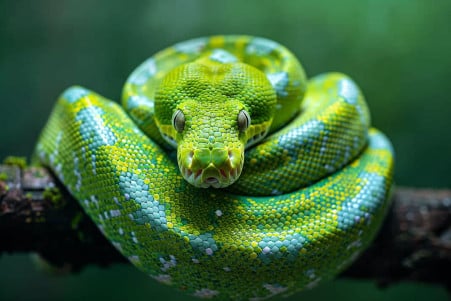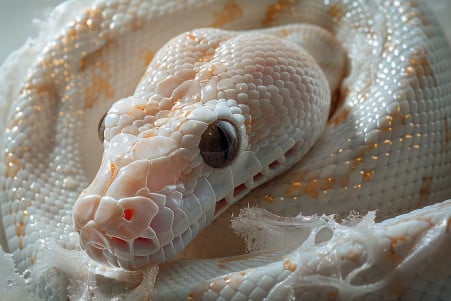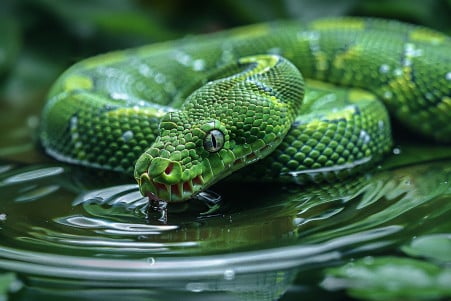How Do Snakes Poop? Decoding the Reptilian Digestive Process
7 March 2024 • Updated 7 March 2024

Snakes are enigmatic animals, but have you ever wondered how they poop? Snakes poop through their cloaca, a single opening that leads to their digestive, reproductive, and urinary systems. Once food has been digested, the poop moves through the snake’s body and out of the cloaca. However, the frequency and specifics of this process can vary between species and depend on a number of factors including diet and the environment.
This article takes a deep dive into the biological and ecological studies that have illuminated how snakes poop. Drawing from research in herpetology, animal physiology, and environmental science, we’ll uncover the interesting ways that snakes poop. This will include looking at everything from the details of snake anatomy to the specifics of their diet and environment to get a comprehensive understanding of the snake’s digestive process, from beginning to end.
How do snakes poop?
The Snake’s Digestive System: An In-Depth Look
The snake’s digestive system is a clear demonstration of the power of natural selection. It has evolved to accommodate the snake’s diet, which often includes prey much larger than the snake itself. From the mouth, snakes can open their jaws wide to swallow their prey whole. This is made possible by the snake’s highly distensible jaws and an esophagus that can stretch to accommodate the prey, as shown by WikiVet.
In venomous snakes, the oral cavity also contains venom glands, which are a modified version of the salivary glands, and help to immobilize and break down the snake’s prey.
Once the prey has been swallowed, it moves into the stomach, where a series of chemical processes work to break it down. The stomach’s muscular walls and gastric juices help to break the prey down into a more digestible form.
This process then moves into the small intestine, where the nutrients are absorbed and waste products are formed. The importance of this process is highlighted by Britannica, which explains that nitrogenous wastes, like uric acid, which is a product of protein metabolism, are prepared for excretion.
The waste then moves into the colon, where it is stored until it’s ready to be expelled. This process is completed in the cloaca, which is a single chamber that the snake uses to collect feces, urinary waste, and, in some species, reproductive materials.
According to Pet Keen, the cloaca is the final stop for waste as it leaves the snake’s body. This system is tailored to the snake’s needs, and the frequency of waste excretion can change based on the snake’s diet and other environmental factors.
Environmental Factors That Impact Snake Digestion
Temperature and environment are key factors in snake digestion and excretion. For example, in a study of boa constrictors, researchers found that both ambient temperature and meal size impacted oxygen consumption rates and digestion time, with higher temperatures leading to faster digestion, as reported on PubMed. This means that snakes in warmer environments may poop more often than snakes in cooler environments.
Similarly, other studies on the Burmese python have shown that while the energetic cost of digestion is the same across different temperatures, higher temperatures lead to shorter digestion times, according to research on ScienceDirect. This means that a snake’s environment, which impacts its body temperature, can have a big impact on digestion efficiency and, by extension, how often snakes poop.
Seasonal changes also impact these biological processes, as shown by cornsnakes that adjust their body temperature after eating to maximize digestion rates, regardless of the size of the meal, as reported in Zoological Studies. These changes in behavior show the complex relationship between the environment and metabolic rate in snakes and how it impacts when and how often they poop.
This knowledge of the environmental factors that impact snake digestion sets the stage for a deeper look at another important part of the snake excretion process: their diet. How snakes turn their food into energy and waste is an interesting process that’s closely tied to their environment and their diet.
Dietary Dynamics: Understanding Snake Digestion and Nutrition
Snakes are obligate carnivores, so their diet consists of a variety of prey that has a significant impact on their digestive and excretory systems.
As WikiVet explains, snakes swallow their prey whole, and the size of the prey can be as large as the snake’s head. Digestion starts in the stomach and ends in the intestines.
The size and frequency of meals are important because larger meals take longer to digest, which impacts how often snakes defecate. A study by Reed, which is available via PMC, found that snakes reduced their activity and were less likely to be detected after eating larger prey, suggesting that they needed more time to digest.
The relationship between nutrient absorption and waste production is also influenced by diet. A study published in PMC found that feeding caused a significant increase in uric acid levels in snake blood plasma, which is the primary waste product of protein digestion, indicating that the composition of a meal directly affects the concentration of waste.
Meanwhile, changes in diet can also affect the frequency and consistency of excretion. Snakes that eat prey with a higher water content are more likely to excrete liquid waste, while those that eat prey with a lower water content, such as birds or insects, are more likely to excrete solid waste.
Knowing how diet impacts snake defecation can help snake owners better understand their snakes’ overall health and digestive efficiency, and it underscores the importance of choosing the right prey and feeding schedule in captivity to ensure healthy excretory functions.
Cloacal Complications: Health Issues in Snakes
While the cloaca is a vital part of the snake’s excretory system, it is also susceptible to a number of health problems. Swelling and even blood in the area can be signs of cloacitis, an inflammation of the cloaca that can interfere with the snake’s ability to defecate normally.
If not treated, the infection can become systemic and even life-threatening. According to PetMD, causes of this condition can include a breakdown in the skin’s protective barriers, internal parasites, or dietary issues that lead to the formation of cloacal stones.
Another serious condition, cloacal prolapse, occurs when the snake’s internal organs are pushed out through the cloacal opening. According to Veterinary Partner VIN, this is a very painful and urgent condition that can be caused by dehydration, constipation, or an improper diet. The condition is usually diagnosed through a physical exam and may be confirmed with the use of imaging studies or endoscopy.
Treatments for these conditions can include removing stones and parasites, surgery, and antibiotics. Preventative measures to help ensure cloacal health are largely focused on good husbandry, especially when it comes to diet. It’s important to make sure that these issues are addressed so that the snake’s digestive system, which is so complex, can continue to work properly from the time the snake eats to the time it eliminates waste.
The Evolution of Snake Waste Removal
Snakes have made some pretty incredible anatomical adaptations to make uricotelism possible. According to a study published in PubMed, snakes, which eat large meals infrequently, have evolved to lower their metabolic rate during fasting and increase it dramatically after eating. This metabolic strategy is an example of an adaptation that conserves energy, and it likely played a role in the evolution of their excretory system to conserve energy between meals.
National Geographic notes that a study by Todd Castoe and Zhi Jiang found that snakes have undergone “evolutionary redesigns” of central proteins involved in aerobic metabolism, which is responsible for both energy production and waste processing. These changes may have evolved in response to the metabolic demands of digesting large prey.
The same study also found that the elongation of the snake body and the evolution of the snake’s right lung are examples of a link between body shape and physiological functions like excretion. These changes show how snakes have been able to evolve the structure of their internal organs to support efficient digestion and excretion.
Oxford Academic highlights these evolutionary changes and notes that reptiles, including snakes, have shown that they can adjust their digestive performance in response to feeding and fasting. This flexibility has been important in the evolutionary history of snakes’ digestive and excretory systems, enabling them to adapt to a wide range of ecological niches.
From Eating to Excreting: The Fascinating World of Snake Poop
In our exploration of snake anatomy, we have traced the intricate process of digestion and excretion in these enigmatic creatures. The cloaca is more than merely an excretory organ; it is a versatile organ that is essential for a snake’s survival. It is involved in excretion, reproduction, and the urinary system, demonstrating the snake’s highly effective anatomy.
We have also looked at how a snake’s diet of whole prey impacts its digestive system and, in turn, the frequency and consistency of its excrement. Meanwhile, we have seen that environmental conditions, particularly temperature and humidity, play a major role in snake digestion, which in turn impacts digestive efficiency and, ultimately, the regularity of defecation. These points highlight how snakes have adapted to a wide range of environmental conditions.
Finally, we have observed the complexity and efficiency of the snake’s digestive system. From the detailed structure of the cloaca to the evolutionary changes that have refined their excretory systems, snakes are an excellent illustration of the interaction between biology and the environment. The process from eating to excreting is an excellent illustration of the smooth integration of shape and role in nature.


